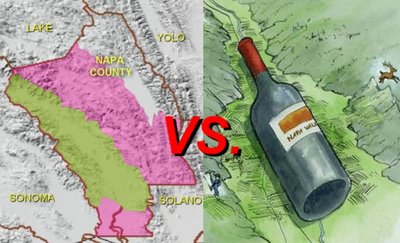Appellation America: work in progress...
 I was asked by Tish the other day if I had posted about the Appellation America (hereafter called AppAm) website and mission.
I was asked by Tish the other day if I had posted about the Appellation America (hereafter called AppAm) website and mission.I have visited the site several times over the past year-or-so, and I think the idea is a good one: one site to showcase the multitude of North American appellations - all over the US & Canada, not just the West coast - and provide some commentary and analysis of the different areas.
When I first visited, my initial take was that the site lacked enough specific information for each area to allow consumers to really get into the differences from one to the next, and the maps of the apps - when available - weren't really useful as they were artists concepts, or too vague to be helpful - though the little man climbing Mt.Veeder & the deer leaping over what's supposed to be Stag's Leap are attractive to newbies.
But recognizing the enormity of what they were trying to accomplish and that the site itself not only states it is constantly under construction, and also elicits help from the public for appellations they are familiar with (sort of a Wikipedia for US & Canadian wine growing regions - a Wine-apedia if you will), and sports some well respected wine industry insiders like Tom of Fermentations, and Dan Berger, who is syndicated nationally, among others.
Still, there should be a topo map which would allow people to see what is properly "Napa Valley" [the green area on the topo map portion above], and that which is legally defined as "Napa Valley" [the purple area added to the green area on the topo map]. This sort of detail would allow visitors to make some judgements about where their wines are coming from, and foster more discussion as well...including the near heretical questioning of whether "Napa Valley" means Napa Valley, or might be something outside of what truly IS the Napa Valley...
Note that I have nothing against the artsy renditions of geographic areas- in fact I think they go a good distance towards eliminating wine elitism by making the subject a bit more fun for people who aren't familiar with the concepts, or who haven't traveled through the area being discussed.
But place the artsy picture at the top of the article, and a more detailed map (topo) within the article, so that people may get a better idea for the geography in question. Then add in some specifics about climate, general geology within the area, etc, and you have a way of bringing people into the subject, and giving them the information they need in the end without seeming elitist - and without them feeling awkward by having to ask (which many neophytes are loathe to do fearing they'll look "stupid" merely by asking). Beware though the equally confusing essay/manifesto by Randall Graham regarding terroir...which would be enough to send most newbies heading for the hills...(I'll resist the urge to deflate his "viticultural acupuncture" and "Ley lines" comments for a future date).
There are also a few odd wine reviews here & there on the site which are a bit confusing. Certainly the site isn't designed to be a comprehensive review of wines from all US appellations, but it seems this area has a bit more work to be done on it...[Take for example this review of a 2002 Murphy-Goode wine from the Alexander Valley in Sonoma County:
"...When I first nosed this wine, from four-year old vines, I didn’t know what to think: it smelled like mushrooms, scrambled eggs, and blackberry pancakes all at once. But after six hours, 24 hours, and 72 hours, it smelled exactly the same – the sign of a wine that’s true to something intrinsic, not tarted up. In your mouth, it’s full of sweet black fruit laced with baking spice delivered in a multi-layered texture that’s warm without alcoholic heat and that expands all the way through to the finish. Worth seeking out for both pleasure and originality.
Reviewed June 22, 2006 by Thom Elkjer."
Hmmm...smelled like scrambled eggs - but that's okay, becuse 3 days later it STILL smelled like scrambled eggs. And I'm not sure what he means by 'tarted up' (for a wine, anyways...I know what it means for women)...is he talking acidity, or what?
Again, is it that wine's supposed to be 'true' to some impossibly underdefined 'intrinsic' quality, or is it suppsed to be 'good'?
Gimme the good wine any day. Those eggy notes are from various sulphur compounds, and are seen as a fault. That they don't decrease over 3 days leads me to think less of that wine.
Good Lord, there's so much to work yet to be done...
[read the review from appellation america website...]
But of all the thoughts I had regarding the site, my biggest concern is that they don't bite off more than they can accomplish, and I think trying to provide descriptions of all the different varietals grown in North America, and the entirety of approved appellations (which is a moving target since the list is still expanding) is quite demanding as it stands.
A lot of work is going to be required to bring it to fruition.
Labels: terroir






